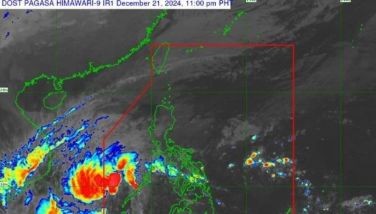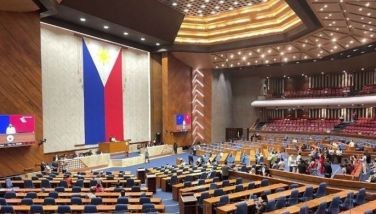A partner in the journey to recovery
CEBU, Philippines - Balay Mindanaw Foundation Inc. (BMFI) Founded in 1996
·Trains communities in disaster preparedness
·Facilitates in the formation, updating, and review of the five-year Barangay Development Plans
·Assists in the growth of partner community’s initiatives
·Established a Peace Center, a meeting place where everyone is welcome regardless of political, religious, and social affiliation
“The biggest achievement a community can give us is when they say ‘go away, we can do it on our own,’” said Charlito Z. Manlupig, also known as Kaloy, Founder and President of Balay Mindanaw Foundation Inc. (BMFI).
This Mindanao-based,non-profit organization trains its energy on the impoverished and conflict-torn areas in Mindanao.
They don’t call the people they help ‘beneficiaries,’ they call them ‘partners.’
“The people are not the recipient of aid, they are the main players in the journey to recovery,” added Kaloy. Balay Mindanaw is guided by its principle: “We refuse to be victims. We choose to be resources.”
Joining the journey
BMFI ensures that its mission, “Helping Build Empowered Sustainable Communities. Helping Build Peace in Mindanaw” and vision, “Kaangayan, Kalambuan, Kalinaw sa Mindanaw, sa Pilipinas, sa Kalibutan (Equality, Development, Peace for Mindanao, for the Philippines and for the World)” are rightfully felt at the micro-level: by the people in the barangay.
“We don’t invite people to join our journey, we join the people’s journey,” are the principles of the organization. Since its registration in May 1996, BMFI has journeyed alongside many lives, both individual and collective, in Mindanao, the place of many peoples divided by beliefs and traditions: Lumads, Muslims, and Christians.
“They capacitate the people. They teach us to be vigilant of the happenings in the community. After Sendong, other NGOs instantly left. They stayed,” shared Mark Kenneth Jalapadan, a resident of Barangay Carmen, a thickly-populated barangay in Cagayan de Oro City. This barangay is one of the partners of BMFI’s Disaster Risk Reduction Management (DRRM) program.
After Sendong and Pablo hit Mindanao, BMFI saw the need for Mindanao to be ready for future disasters, both natural and manmade.
“After Sendong, out of 2,000 houses standing in the Carmen-Macasandig area, only one remained after the water subsided,” recalled Rochelle Mordeno, Executive Director of BMFI.
Before its intervention, most, if not all, partner communities’ capacity was limited only to rescue. Preparedness for disaster was a foreign idea to them. EdizonSuizon, Barangay Carmen’s disaster coordinator, shared that “before BalayMindanaw, the people did not care.”
Implementing plans
They conducted trainings and workshops to strengthen the resilience of barangays, especially vulnerable ones like Carmen, in consideration of responding to potential disasters.
The barangays, indeed, are the locus and focus of BMFI’s work.
The formulation, review, and updating of the five-year Barangay Development Plan (BDP) is one of its successful programs. Balay Mindanaw found that barangays simply copied their previous BDPs, overlooking issues, needs, and concerns relevant to the community at present.
“We were lucky. Very lucky to have an NGO that really works for the community. The best part is the formulation of our five-year development plan. Everyone was represented and they were involved. Bottom-up approach. BDP is our bible,” said Marlo L. Tabac, chairman of Barangay Gusa.
Balay Mindanaw helps facilitate and develop the development plans in the barangays. This approach aims to address the issues of poverty by helping communities in formulating projects and programs geared towards the community.
With a well-defined five-year plan, a barangay like Gusa can gain the support of its partners. This can then pave the way for the successful implementation of programs and projects like waste management, potable water systems, and container gardening.
To gain the community’s trust, BMFI starts with immersion and trust-building activities. Its strength is its trust in people.
“There is no such thing as partial trust. It is there or it is not,” stressed Kaloy, highlighting the importance of building trust and partnerships with the people.
The organization works closely with their partner communities. They have Sustainable Integrated Area Development Organizers (Siado) who work as shadows helping the communities and monitor their initiatives.
All partners
“There are no enemies — only partners. It is inclusive. No one should be left out. No community is monolithic. There is nothing more political than empowering the people,” said Kaloy, the man behind it all.
While Mindanao remains to be known as an area of armed struggle, BalayMindanaw believes that peace is attainable. They believe that the armed struggle in Mindanao is rooted in the community’s underdevelopment which is in turn caused by the unequal distribution of resources in the society.
Balay Mindanaw’s headquarters in Cagayan de Oro has become the “Peace Center,” where everyone has to remove their titles, badges, guns, and even their footwear and enter on equal footing.
The Peace Center has become a meeting place for everyone: be it rebels or members of the Philippine National Police (PNP).
Partner communities also have their own centers, where people gather, discuss, plan, and learn.
Balay Mindanaw also offers an education program called “OP KORS (Operation Peace Course)” which is instrumental in the establishment and maintenance of peace and order. They also have community-based Peace Builders, training over 600 community leaders on peace building and conflict management.
Balay Mindanaw, as its name suggests, intends to be a home for everyone. Built as a tribute to the people of Mindanao, it aspires that Mindanao to be a home for everyone – a home where there is justice, equity, and peace.
(Balay Mindanaw is one of five finalists in the institution category of the 6th RAFI Triennial Awards. The winner in the category will be revealed Friday, August 14.) (FREEMAN)
- Latest





















